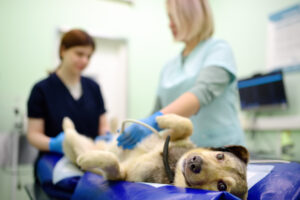Understanding Anaphylaxis in Dogs
 Anaphylaxis is a potentially life-threatening condition in dogs that all pet owners should be educated about. By understanding the causes, symptoms, and treatments for anaphylaxis, you can help save your dog’s life in an emergency. In this post, we’ll walk through everything you need to know about anaphylaxis in dogs and how to protect your furry friends.
Anaphylaxis is a potentially life-threatening condition in dogs that all pet owners should be educated about. By understanding the causes, symptoms, and treatments for anaphylaxis, you can help save your dog’s life in an emergency. In this post, we’ll walk through everything you need to know about anaphylaxis in dogs and how to protect your furry friends.
What is Anaphylaxis in Dogs?
Anaphylaxis in dogs is a severe allergic reaction that occurs when a dog’s immune system overreacts to a substance it has identified as foreign, such as a toxin, allergen, or even a protein. The reaction can be immediate and typically affects multiple systems in the body, including the cardiovascular, respiratory, and digestive systems. Anaphylaxis differs from regular allergic reactions because of its speed and severity. If left untreated, anaphylaxis can lead to anaphylactic shock, which can be fatal and requires immediate emergency care.
Causes of Anaphylaxis in Dogs
Anaphylaxis in dogs can be caused by a variety of allergens (substances that cause allergic reactions), including food, insect toxin from bites, and medications. The most common causes of anaphylaxis in dogs are:
- Insect stings and bites: Bees, wasps, hornets, and fire ants are frequent culprits.
- Medications and vaccines: Some dogs may have adverse reactions to vaccinations, antibiotics, or other medications.
- Food allergies: Although rarer, certain food proteins can provoke anaphylactic reactions.
- Chemicals and pollutants: Dogs can also develop reactions to environmental allergens like household cleaners or pesticides.
The first exposure to an allergen usually doesn’t cause much of a reaction at all, if any. However, when exposed to the allergen again, the dog’s immune system overreacts, leading to a more severe reaction and possibly anaphylaxis. This is why you cannot rule out a substance as a potential allergen just because the dog has been exposed to it once before.
Signs & Symptoms of Anaphylaxis in Dogs
Recognizing the symptoms of anaphylaxis early can make all the difference in saving your dog’s life. Symptoms can vary from dog to dog, so be on the lookout for any of the following:
- Vomiting and diarrhea
- Swelling of the face, muzzle, or neck
- Hives or welts on the skin
- Difficulty breathing or wheezing
- Excessive drooling
- Lethargy or collapse
- Rapid heartbeat and weak pulse
- Pale or bluish gums
Since anaphylaxis can cause symptoms to escalate quickly, it’s essential to get your dog to the vet as soon as possible if you notice any of these signs.
Treatment for Anaphylaxis in Dogs
Anaphylaxis is a medical emergency for all animals (humans included) and requires immediate care. If you notice any signs of anaphylaxis in your dog, take them to the nearest veterinary care facility immediately. Here’s what to expect during diagnosis and treatment:
- Emergency stabilization: The veterinarian will first remove the allergen if possible (e.g., removing a bee stinger) and stabilize your dog’s vital signs. This may include administering oxygen and inserting a breathing tube if necessary.
- Medications: Epinephrine is often the first line of treatment to combat the severe allergic reaction. Antihistamines and corticosteroids may also be given to control inflammation and ease symptoms.
- Fluids and support: Intravenous fluids are commonly administered to stabilize blood pressure and support circulation. In some cases, additional drugs may be required to improve heart function and assist in breathing.
- Observation: After the immediate crisis is managed, your dog will likely need to be monitored for at least 24-48 hours to ensure that there are no further complications.
Ways to Prevent Anaphylaxis in Dogs
Prevention is always better than cure, but predicting what will cause an anaphylactic reaction can be difficult. However, there are steps you can take to minimize the risk of a reaction for your dog:
- Avoid known allergens
If you know what your dog is allergic to, avoid exposing them to those triggers. For example, if your dog has had a reaction to a bee sting, keep them away from areas with high bee activity.
- Be cautious with medications and vaccines
Always consult your vet about potential allergic reactions before giving your dog new medications or vaccines. In some cases, pre-treatment with antihistamines may be recommended.
- Keep your environment safe
Clear your yard of insect-attracting plants, and be mindful of pesticides and chemicals that could trigger a reaction.
Anaphylaxis Treatment for Tampa Bay Pups
At Affordable Pet Hospital in Tampa Bay, we understand how terrifying an anaphylactic reaction can be for both you and your dog. That’s why we are well-equipped to handle these emergencies with the latest treatments and technology, helping to ensure the best possible outcome for your pet. If you suspect your dog is experiencing anaphylaxis or is at risk, contact us immediately at 813-991-9898 (office line) or 813-991-9244 (24/7 emergency line). For non-emergency issues, you can also request an appointment online. We’re here to help you manage your pup’s allergies so that they live a happy, healthy life!

 All good dog owners make their
All good dog owners make their  From the best food to daily walks to routine vet visits, we do everything we can to keep our furry friends happy and healthy. So what other things can a responsible dog owner do to ensure their pup is in the best health possible? One important part of holistic pet care is regular health testing. Health testing allows vets to get a better picture of a dog’s current condition and can even help identify problems that may pop up down the road. In this post, we’ll explain why health testing for dogs is important, the most popular health tests for dogs, the benefits of health tests for dogs, and where to get health testing for your dog in Tampa.
From the best food to daily walks to routine vet visits, we do everything we can to keep our furry friends happy and healthy. So what other things can a responsible dog owner do to ensure their pup is in the best health possible? One important part of holistic pet care is regular health testing. Health testing allows vets to get a better picture of a dog’s current condition and can even help identify problems that may pop up down the road. In this post, we’ll explain why health testing for dogs is important, the most popular health tests for dogs, the benefits of health tests for dogs, and where to get health testing for your dog in Tampa. Dermatitis is an inflammatory skin condition, some types of which are estimated to affect up to 30% of all dogs. It causes excessive itching and discomfort if left untreated. While dermatitis is a lifelong condition for pups, proper treatment and management can significantly reduce symptoms and increase quality of life. In this post, we’ll take an in-depth look at what dermatitis is, how to recognize it, and what steps you can take to treat and prevent it.
Dermatitis is an inflammatory skin condition, some types of which are estimated to affect up to 30% of all dogs. It causes excessive itching and discomfort if left untreated. While dermatitis is a lifelong condition for pups, proper treatment and management can significantly reduce symptoms and increase quality of life. In this post, we’ll take an in-depth look at what dermatitis is, how to recognize it, and what steps you can take to treat and prevent it. When your dog is pregnant, you want to do everything you can to make sure they’re healthy and happy. There’s a lot to prepare for and think about leading up to the big day, and for most dogs, pregnancy and birth are smooth sailing. However, there are times when the safest option for a dog’s birth is via cesarean section (C-section). In fact,
When your dog is pregnant, you want to do everything you can to make sure they’re healthy and happy. There’s a lot to prepare for and think about leading up to the big day, and for most dogs, pregnancy and birth are smooth sailing. However, there are times when the safest option for a dog’s birth is via cesarean section (C-section). In fact, 
 If your dog has even thrown up
If your dog has even thrown up  At Affordable Pet Hospital in Tampa, we are aware of the recent media reports about an emerging unknown canine respiratory illness affecting dogs across various states in the U.S., including Florida. During this time of year, it’s not unusual to see an uptick in respiratory infections among dogs. However, this particular illness is drawing attention due to its undefined nature, lacking a specific name, clear cause, or established treatment protocol.
At Affordable Pet Hospital in Tampa, we are aware of the recent media reports about an emerging unknown canine respiratory illness affecting dogs across various states in the U.S., including Florida. During this time of year, it’s not unusual to see an uptick in respiratory infections among dogs. However, this particular illness is drawing attention due to its undefined nature, lacking a specific name, clear cause, or established treatment protocol. As veterinarians with years of experience treating our furry friends, one of the most common concerns we hear from pet owners is about their dog’s
As veterinarians with years of experience treating our furry friends, one of the most common concerns we hear from pet owners is about their dog’s  As pet owners, we always want the best for our furry friends. Their
As pet owners, we always want the best for our furry friends. Their 